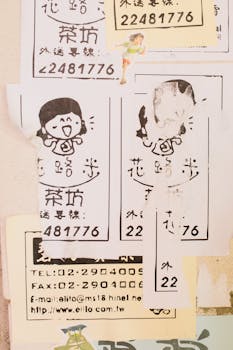Understanding the Basics of Mandarin Chinese Characters
Dive into the beautiful complexity of Mandarin Chinese characters, a unique blend of visual art and linguistic function that has stood the test of thousands of years. There's a fascinating world to explore beyond the initial complexity, and understanding these basics sets the foundation for your journey to mastery.
The Complexity and Beauty of Mandarin Chinese Characters
Unlike the Latin alphabet that's phonetically based, the Chinese writing system is logographic. This means that each Chinese character represents a whole syllable and often carries its own distinct meaning. Unraveling these syllables and meanings is like solving a captivating puzzle, where each piece contributes to a larger, beautiful image.
The complexity of Chinese characters lies in their structure, which can be broken down into smaller components. These components, known as radicals or "bushou", often provide a hint to the meaning or pronunciation of the character. For instance, the character "休" (to rest) is composed of the radicals "人" (person) and "木" (tree), suggesting a person resting under a tree.
Traditional vs Simplified Chinese Characters
Chinese characters come in two forms: Traditional and Simplified. Traditional Chinese characters are more ancient, often more complex, consisting of more strokes and intricate details. They've been used for centuries in regions like China, Taiwan, and Hong Kong.
On the other hand, Simplified Chinese characters, introduced in the mid-20th century in Mainland China, have fewer strokes and are easier to write. This script is widely used in Mainland China, Singapore, and Malaysia. For example, the traditional character for "love" (愛) includes the "heart" (心) in its composition, which is absent in the simplified version (爱).
Understanding these forms and their differences is a crucial part of your Mandarin learning journey. Whether you're learning Simplified or Traditional Chinese largely depends on your learning goals and the region you're interested in.
The Importance of Mandarin Chinese in Today's World
Mandarin Chinese is one of the most spoken languages globally, with over a billion native speakers. As China continues to grow as a global powerhouse, the importance of learning Mandarin Chinese, including mastering the writing system, becomes increasingly crucial. Whether you're learning for personal enrichment, professional advancement, or cultural appreciation, Mandarin Chinese offers unique opportunities in today's interconnected world.
Acquiring the ability to write Mandarin Chinese characters is not just about learning another language; it's about understanding a different way of thinking, expressing, and perceiving the world. It's a journey that broadens your intellectual horizons and deepens your cultural appreciation. And with the right approach, tools, and techniques, you can successfully master this art. Stay tuned as we delve further into the structure of Mandarin Chinese characters and uncover effective strategies for learning them.

The Structure of Mandarin Chinese Characters
Like an intricate puzzle, each Mandarin Chinese character is assembled with care and precision. Understanding this structure is key to mastering the art of writing these characters.
The Role of Radicals in Chinese Characters
Think of radicals or "bushou" as the backbone of Chinese characters. These crucial building blocks often provide a hint to the meaning or pronunciation of the character, serving as a functional component. For example, the character "休" (to rest) is composed of the radicals "人" (person) and "木" (tree), suggesting a person resting under a tree.
By familiarizing yourself with the basic radicals, you'll start to see patterns and connections between characters, which can significantly aid your memorization and understanding. A character's radical can also assist in looking up unfamiliar characters in a dictionary, making it an invaluable tool in your Mandarin learning journey.
The Concept of Stroke Order in Writing Chinese Characters
The stroke order in writing Chinese characters is another crucial aspect to consider. This refers to the sequence in which the lines and curves (or strokes) are drawn to form the character. Correct stroke order helps ensure the characters are written correctly and legibly and also aids in memorizing characters.
The Logical Construction of Chinese Characters
Lastly, understanding the logical construction of Chinese characters can be a game-changer in your learning journey. Each character often consists of components known as "radicals". These radicals are basic characters that can't be simplified any further. They give either phonetic or semantic clues and can combine to create more complex characters.
For instance, the radical "木" (mù) represents wood, offering a clue to the meaning of characters that contain it. By breaking down characters into their individual components, you can gain insights into their meanings, making them easier to memorize and recall.
In summary, mastering Mandarin Chinese characters involves understanding their structure, including the role of radicals, the concept of stroke order, and the logical construction of the characters. With this foundation, you're well on your way to becoming proficient in writing Mandarin Chinese characters.

Techniques to Master Writing Mandarin Chinese Characters
The Power of Mnemonics in Learning Chinese Characters
Harnessing the power of your memory through mnemonic techniques is a game-changing strategy in learning Mandarin Chinese characters. Mnemonics are essentially memory aids that enable your brain to form vivid, memorable associations with Chinese characters. For instance, you could visualize the character 木 (mù) as a tree, creating a strong mental link between the character and its meaning.
The goal of mnemonics is to serve as a stepping stone, bridging the gap between not knowing and knowing. Over time, you'll find yourself relying less on these memory aids as your familiarity with the characters grows. But remember, mnemonics are not a permanent crutch—rather, they're a temporary support system to boost your recall.
And while there's a common misconception that mnemonics are slow and time-consuming, they're actually incredibly useful for initial recall. Even if the recall process is slow at first, it's still better than not recalling at all. As you progress, you'll gradually wean off mnemonics, except for handwriting characters, where they continue to be useful.
The Role of Visual Graphics in Understanding Chinese Characters
Visual aids play a significant role in learning Mandarin Chinese characters. Remember, Chinese characters are not just random sets of lines and curves—they often follow certain patterns and structures, particularly when they contain common radicals or components. Recognizing these patterns can make learning new characters easier and more efficient.
By visualizing the patterns and structures of characters, you can create a mental map that can help you remember and understand new characters. For example, the radical 斤 (jīn), which represents an ax head, appears in several different characters. Once you've identified this pattern, you can leverage it to learn and remember new characters.
The Importance of Regular Practice in Mastering Chinese Characters
The old adage "practice makes perfect" rings especially true when learning Mandarin Chinese characters. Regular practice is crucial for reinforcing your memory and improving your recall. Frequent reviews of the characters you've learned, combined with the use of flashcards, can greatly enhance your memory.
Incorporate Mandarin Chinese into your daily routine, diversifying your study methods as much as possible. Engaging in various activities such as listening to Chinese while going about your daily tasks, writing characters on your shower walls, or reviewing your flashcards while waiting in line can significantly improve your learning efficiency.
To sum up, mastering writing Mandarin Chinese characters is a journey. With the right techniques and a commitment to regular practice, you can make significant strides in your Mandarin skills. Remember, the goal is not just to learn the characters but to understand and remember them, which is achieved through a combination of mnemonics, visual graphics, and consistent practice.
Utilizing Traverse and Mandarin Blueprint for Learning Mandarin Chinese
Elevate your Mandarin learning journey with the power of technology. By combining the right tools, you can streamline your learning experience, making it more efficient and engaging. Two such tools that can significantly enhance your Mandarin learning are Traverse and Mandarin Blueprint.
The Unique Features of Traverse for Learning Mandarin Chinese
Traverse is an innovative language learning platform known for its science-based approach to language learning. It uses the concept of Spaced Repetition, which is a proven method to enhance memory retention. This methodology involves spreading out review sessions over increasing intervals of time, which is particularly effective for learning Mandarin Chinese characters.
Moreover, Traverse offers a high level of customization, allowing you to modify the order of flashcards, adjust what plays first based on your preferences, and even focus on specific areas like listening comprehension. These features make it a powerful tool for mastering the art of writing Mandarin Chinese characters.
The Partnership between Traverse and Mandarin Blueprint
Traverse has partnered with Mandarin Blueprint, an online Chinese course that focuses on character learning and immersion learning. This partnership makes learning Mandarin more accessible and enjoyable as it combines the innovative learning methods of Traverse with Mandarin Blueprint's comprehensive curriculum.
This collaboration has not only improved customer satisfaction but also boosted conversion rates. It has allowed the Mandarin Blueprint team to focus more on their curriculum development, thereby offering you an enriched learning experience.
How to Import Anki Decks into Traverse for Continued Learning
Another unique feature of Traverse is its compatibility with Anki, a popular flashcard app among language learners. You can easily import your Anki decks into the Traverse app. The platform preserves your scheduling information, allowing you to pick up right where you left off.
To import your Anki decks, you simply need to upload the Anki APKG file to the app. For optimal performance, it is recommended that the file size be below 300MB. However, if you have larger decks, you can export the subdecks from Anki and import them into Traverse one at a time.
By leveraging the advanced features of Traverse and the comprehensive curriculum of Mandarin Blueprint, you can supercharge your Mandarin learning journey. The result is a more engaging, efficient, and rewarding experience in mastering Mandarin Chinese characters.

The Role of Spaced Repetition in Learning Mandarin Chinese Characters
If you've ever found yourself forgetting a new word or character just days after learning it, you're not alone. This is a common challenge faced by language learners worldwide. But, luckily, there's a powerful tool in our learning arsenal that can help combat this - spaced repetition. In this section, we'll explore the concept of spaced repetition, its benefits for learning Mandarin Chinese characters, and how to implement it using the Traverse platform.
Understanding the Concept of Spaced Repetition
Spaced repetition is a scientifically-backed learning technique that's all about timing. Rather than cramming all your study into one session, spaced repetition involves reviewing information at specific intervals. The idea is to re-engage with the information just before you're likely to forget it. This method is based on the psychological spacing effect, which suggests that information is better retained when reviewed at spaced intervals rather than in rapid succession.
The Benefits of Spaced Repetition in Learning Mandarin Chinese Characters
Spaced repetition is particularly effective in learning Mandarin Chinese characters. Mandarin Chinese is a character-based language, with each character representing a syllable and carrying a meaning. With thousands of characters to learn, it can seem an overwhelmingly daunting task. But repetition, specifically spaced repetition, helps you to recognize patterns, making it easier to remember and understand these characters.
By reviewing the characters at strategic intervals, you reinforce your memory of them. The characters you find challenging will be reviewed more frequently, allowing you to focus your attention on them, while the characters you recall easily will be reviewed less often. This approach turns the initially intimidating task of learning thousands of characters into a manageable one, anchoring these characters in your long-term memory.
How to Implement Spaced Repetition Using Traverse
The next step is clear: how to integrate this powerful technique into your Mandarin learning journey. The good news is that spaced repetition is a key feature of the Traverse platform. Traverse uses advanced algorithms that adapt to your performance, scheduling reviews at the optimal time to aid retention.
By leveraging the powerful spaced repetition feature of Traverse, you can ensure that your effort is maximized. You'll be reviewing the characters you find challenging more often, while the ones you find easy will be presented less frequently. This personalized approach helps you focus your attention where it's needed most, making your study sessions more effective and efficient.
Incorporating spaced repetition into your Mandarin learning routine can be transformative. It's not just about learning Mandarin Chinese characters; it's about remembering them. And with the help of Traverse and the power of spaced repetition, you'll be on your way to mastering Mandarin Chinese characters in no time.
Next, let's delve into some additional tips and tricks that can help you learn Mandarin Chinese characters even faster. From learning pronunciation alongside writing to learning characters in context, there are numerous strategies you can employ to supercharge your learning journey.
Tips and Tricks for Learning Mandarin Chinese Characters Fast
Unlock your Chinese writing potential with these game-changing strategies. These tips, when implemented effectively, can significantly speed up your Mandarin Chinese character learning process and improve recall. Whether you're a beginner just starting out or an intermediate learner looking to refine your skills, these tips will provide you with a solid foundation for mastering Mandarin Chinese characters.
The Importance of Learning Mandarin Chinese Pronunciation Alongside Writing
When it comes to learning Mandarin Chinese characters, understanding the pronunciation is just as important as learning to write them. As pointed out by Hacking Chinese, most Chinese characters look the way they do because of how they are pronounced. Learning the meaning and pronunciation together can make the learning process much more efficient and enjoyable.
By tying together the meaning, pronunciation, and written form of a character, you create a robust mental image that helps in both recognition and recall. Start with learning the Pinyin (the phonetic system of Chinese) and tones for each character as you learn to write them. This way, you not only learn how to write Mandarin Chinese characters but also how to pronounce them correctly, creating a comprehensive understanding of each character.
The Benefit of Learning Commonly Used Characters First
When starting out, focus on learning the most commonly used Mandarin Chinese characters. This approach provides maximum value for your effort. According to the Hacking Chinese article, taking the time to identify which characters and words are most relevant to your learning goals can make the learning process much more efficient.
Furthermore, by focusing on commonly used characters, you will find that you can start reading and recognizing these characters in real-world contexts sooner. This leads to a rewarding and motivating learning experience. Platforms like Traverse can be of great help as they provide spaced repetition flashcards for the most frequently used words.
The Advantage of Learning Characters in Context
Learning Mandarin Chinese characters in isolation can be a daunting task. However, when you learn a new character, pairing it with a corresponding word or phrase can provide context, making it easier to remember. As Traverse suggests, this method not only enhances your vocabulary but also provides a vivid context that aids in memorization and recall of the character.
For instance, instead of just learning the character for "eat" (吃), learn it in the context of a simple phrase like "I eat rice" (我吃米). This provides more meaning to the character and makes it easier to remember. Over time, you will find that you can recognize and understand these characters more easily when you encounter them in other contexts.
By combining these strategies with the use of innovative learning platforms like Mandarin Blueprint, you can enhance your character learning efficiency and make your Mandarin learning journey a successful one.
Conclusion
Mastering Mandarin Chinese characters is an enriching journey that opens up a new world of linguistic and cultural understanding. It may be challenging at first, but with the right techniques and tools, this seemingly complex task becomes manageable and even enjoyable.
Remember, the key to success lies in understanding the structure and logic of Chinese characters, harnessing the power of mnemonics, visual graphics, and regular practice. Don't shy away from the complexities; instead, embrace them and use them to your advantage.
Platforms like Traverse and Mandarin Blueprint can significantly enhance your learning experience, making your journey more efficient and engaging.
Remember, learning is a marathon, not a sprint. Take the time to understand each character, its strokes, and its meaning. The more you practice, the more natural it will become, and the more you'll find yourself enthralled by the beauty and complexity of Mandarin Chinese characters.
As you continue to learn, don't forget the value of feedback and continuous improvement. This is not a static process; it's a dynamic one that evolves with you. Be open to trying new strategies and tools, and don't hesitate to adjust your approach if you find something isn't working for you.
In the end, the reward is worth the effort. You'll not only be able to communicate in one of the world's most widely spoken languages, but you'll also gain a deeper understanding of a rich and fascinating culture.
So, keep writing, keep learning, and keep exploring the world of Mandarin Chinese characters. Your journey is only just beginning, and the destination is well worth the travel. Remember, every character you master brings you one step closer to fluency. 加油 (jiāyóu, "keep it up")!

